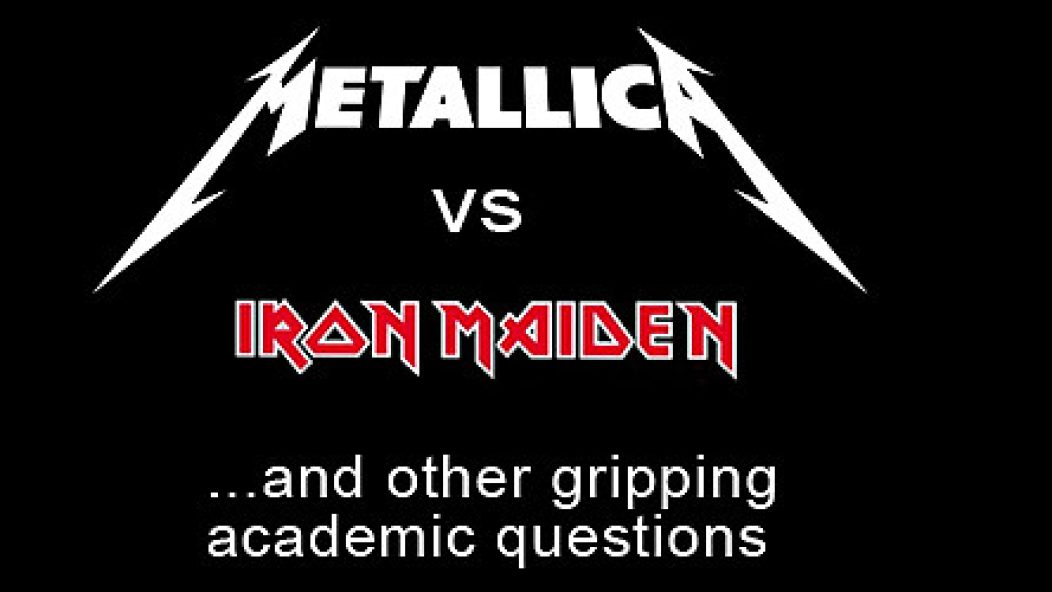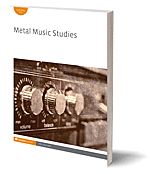
New Journal Takes Academic Look at Metal
On November 1, 2014, to no fanfare, Volume 1 Number 1 of a new academic journal was published. This one’s not a peer-reviewed publication about major medical advancements or alternative pathways to explaining evolution. No, it’s much more interesting—it’s about Metal Studies.
The editors, Karl Spracklen (Leeds Beckett University) and Niall Scott (University of Central Lancashire) have spawned Metal Music Studies as the product of 6 years spent talking about bringing together scholars interested in metal music. There’s even an International Society for Metal Music Studies, to which you can submit an enquiry about joining if you are not already a card-carrying study-head.
Society at large has had increased opportunities to grok the purpose and motivation of the filthy, violent, Satanic metalhead hoards in recent years, thanks in part to anthropology student Sam Dunn‘s decision to switch his academic focus from Guatemalan refugees to leather-clad rock and rollers. His film, Metal: A Headbanger’s Journey and subsequent television series Metal Evolution gave Dunn the opportunity for an objective look at the metal tribal caste. Even though many metalheads enjoyed watching Dunn’s work, in large part it was an attempt to help non-metalheads understand what we crazies were really up to. This journal, however, is meant for us. “This is the journal for anyone who wants to write and read about metal music studies,” says the introduction.
While some music fans might find the very concept of academically studying metal repulsive, editor Niall Scott, a metalhead since his first Kiss tape at age 8, has other sentiments. “I’m interested in the philosophy values and ideology in metal–the thinking behind the growls. There is such a diverse range of things expressed through the music and in its culture. It is a rich and varied spectrum that illuminates features of the human condition that very few forms of artistic and popular culture expression touch on.” In other words, to him it’s a natural fit. He mentioned other areas of academic study interested in metal, including particle physicists studying mosh pit behavior, and sociologists in France who are collecting information on Clisson’s annual metal festival, Hellfest.
Scott also believes that metal has something to offer academics that is more valuable than being some sort of intellectual sideshow. “Metal studies also stands to critique traditional academic approaches to study because like metal itself, it is interdisciplinary,” he said. “Material coming out soon on heavy metal and gender is testament to that very diversity and interdisciplinarity. The journal Metal Music Studies will see some special issue coming out focusing on specific subjects and events. The study of metal has a darkly bright future indeed.”

The journal contains nine lengthy articles, starting with “Amalgamated anecdotes: Perspectives on the history of metal music and culture studies,” and ending with a section containing reviews of books such as “Black Metal: Evolution of the Cult,” by Dayal Patterson. There’s also a review of a book by Michelle Philipov called “Death metal and music criticism: Analysis at the limits,” which takes on the subject of the mental disassociation from lyrical imagery. We can listen to a band like Carcass or Cannibal Corpse in all of their sick, putrefying lyrical greatness, but not get emotionally warped by the violent wordplay. Academics call this “reflexive anti-reflexivity,” or “knowing better but deciding not to know.” We get this explanation: “Due to Carcass’s lyrics about and imagery of dismembered bodies and their musical fragmentation, the practice of reflexive anti-reflexivity can enable listeners to explore the pleasures of corporeal or subjective disintegration without reflecting on the politics of these representations. Listening to Carcass offers a space where listeners can embrace the experiences of contradiction, disequilibrium and subjective disappearance.” This explanation makes as much sense as any reason for liking the stuff that I’ve ever thought of.
I was initially drawn to “Dark epistemology: An assessment of philosophical trends in the black metal music of Mayhem,” (more on that later) but there’s also an article pitting Iron Maiden against Metallica. It’s called, “The Trooper or the Sandman? Iron Maiden’s conservatism versus Metallica’s experimentalism in their philosophies towards musical creativity,” and it’s written by a Cambridge University student who got to listen to The Number of the Beast and Ride the Lightning over and over on class time. The article describes the two bands as “load-bearing pillars” whose creative weights are unequally distributed: “Iron Maiden’s creative conservatism has become synonymous with notions of ‘authenticity’ in heavy metal music, whereas Metallica’s creative adventurism has been equated to ‘selling out.’” I can’t wait to read your comments based on that sentence alone.
One article, “Lyrical stresses of heavy metal and rap,” involved playing 210 college students either a rap or heavy metal version of a song to determine retention and understanding of lyrical themes. Short answer: Students who heard the heavy metal version paid less attention to the song’s themes and had worse lyrical recollection. My first reaction was to throw the horns for mindlessness. But, when I comprehended the perceived consequences of this study—that the (misogynistic, race-bashing, violent) lyrics of a gangster rap song has more cultural currency because it is remembered and internalized more easily than a heavy metal song—some fundamental societal issues started to click into place in my mind.
Readers of our series of metal music in Africa will probably enjoy reading
“Headbanging in Nairobi: The emergence of the Kenyan metal scene and its transformation of the metal code.” There’s also “Predictors of communal formation in a small heavy metal scene: Puerto Rico as a case study,” which unpacks the sad fact that listening to metal music is most often viewed as a red flag, a sign of mental instability. The Puerto Rican metal scene is used as an example of metal building a positive community. Because of the island’s small size, the members of the metal scene constantly interact with each other face-to-face. There’s no media or radio support for the scene, so the geographical factors have created a “need to survive” culture where communal experience becomes paramount.
I’m planning on examining more closely (and sharing here) one article, “Determinants of the production of heavy metal music,” because it discusses something I’ve thought about but couldn’t narrow down enough to figure out how I would approach writing about it: The demographic and economic factors that account for why some countries have so many metal bands and others don’t.
Production nerds will want to check out “Tracking timbral changes in metal productions from 1990 to 2013.” In other words, Pro Tools and the effects of computer-aided developments in acoustics and loudness manipulation.
Now, back to “Dark epistemology: An assessment of philosophical trends in the black metal music of Mayhem.” This was written by Jesse McWilliams, a biology instructor at Midlands Technical College in South Carolina who holds psychology and biology degrees. The genre of black metal is introduced as “an iteration of a ‘relationship with evil, darkness and anti-conformity’.” Fuck yeah. It is comforting going into this thesis knowing that the authors are approaching the subject with this knowledge, but it’s still surreal reading about such an emotionally charged subject written about in such clinical language as, “black metal is the release of aggression, and Mayhem attempted to produce a unique aggressive sound,” with an annotation describing where that quote first appeared in a separate academic paper.
It’s made clear that black metal is quantitatively different from other genres. One quote from a referenced author says that black metal is indifferent to human expectation and that it exists in opposition to labeling. I couldn’t agree more.
I read this article expecting and wanting examples of Mayhem’s lyrics and what the authors thought they meant and why they mattered to society at large. Instead, we get a philosophical explanation of what the word definition means, calling into being Wittgenstein’s negation of absolute knowledge and Sartre’s idea that perception is merely illusion and all that.
“The Black metal theory movement for example, plunges deep into dark recesses of the imagination, pondering our relationship to a damaged world both in terms of nature and humanity,” explained Scott. “It explores negation as positive force and how black metal has been an instigator for this kind of enquiry.” I would have liked more black metal and less theory in the articles.
Finally, there’s a section in the article called “Misanthropy.” I thought I would find my lyrical warm blanket here, but no. It’s Shakespeare and Nietzsche all day . . . What is good? What is bad? The weak and the botched shall perish, and maybe we should even help them along. Mayhem the band is in the title but plays little role in this article. Rather than examining lyrics, comments in by people in the band—drummer Kjetil Manheim, bassist Jørn Stubberud (Necrobutcher) and guitarist Rune Eriksen (Blasphemer)—are used to help frame a discussion of epistemology (the study of knowledge and understanding) and how that fits in with post-modern philosophical theory.
The journal has value to metalheads as non-academics because it holds up a mirror to us. Scott said he’s learned this much about metal from editing volume one: “At its core I think metal carries with it a banner of arbitrary resistance predicated on the paradox of community and individualism–it is a movement that wants to be left alone to do its thing, but at the same time seeks out companionship. The establishment struggles to deal with this kind of paradox precisely because it defies definition other than ‘being metal.’ But metal is so incredibly diverse so maybe this is its difference.”
Overall, Volume 1 Number 1 of Metal Music Studies published researched views on topics that many of us not on the degree track have thought about, either in passing or at length over extended bong sessions. The idea of academic conferences and peer-reviewed papers on metal make me uncomfortable in much the same way as hearing metal bands talking about brand identity and marketing, but there’s no denying that metal is as rich a subject for study as any out there. For now, you can download PDFs of these articles at no charge.
. . .












